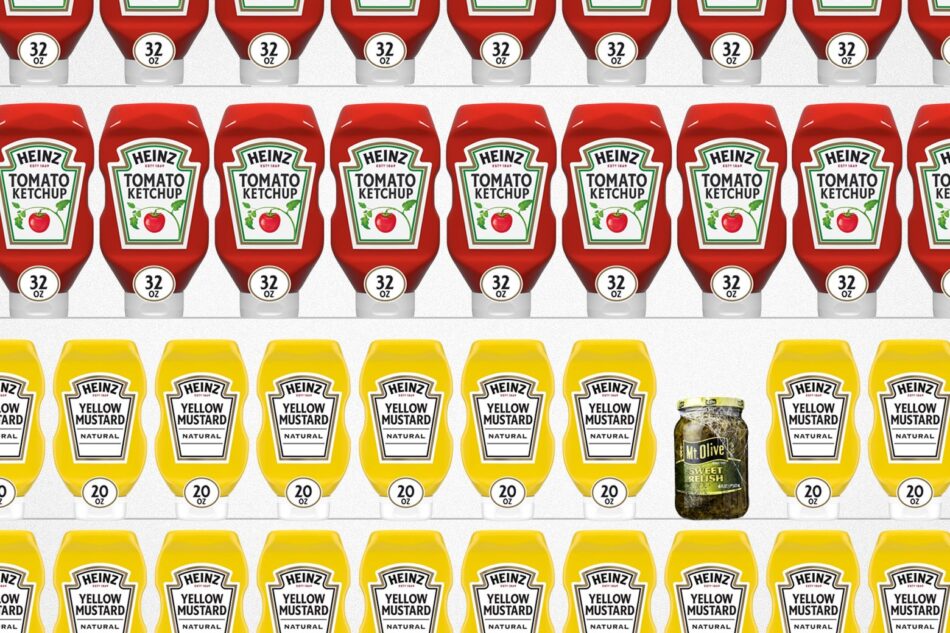Sign up for the Slatest to get the most insightful analysis, criticism, and advice out there, delivered to your inbox daily.
Recently, while I was visiting my paternal grandmother and my younger brother in Philadelphia, I promised to make us tuna salad for lunch. A key ingredient of my tuna salad recipe (as taught to me by my mother) is sweet pickle relish—the Teenage Mutant Ninja Turtle–green style you might picture in the squeeze container from Heinz (though I am brand-agnostic). But alas, it was not to be found in my Jamaican grandmother’s pantry. This was not a total shock; she has an incredibly discerning palate and is the kind of cook who makes her own mango chutney. Still, my salad needed its relish, so off to the grocery store we went. However—disturbingly—I couldn’t even find it at first. When I did, the few shelves of relish were wasting away at the very bottom of the aisle, below all the apparently more desirable sauces and spreads. And this is not the first time of late that I’ve encountered such a sad, dismissive arrangement.
Later, as I savored my properly creamy and yet piquant tuna salad, I began to ruminate: Relish seems to be suffering! When was the last time a dinner guest asked me for some? When was the last time I came across an online recipe that called for it? I’m almost positive that the last time I went to a cookout in New York City, no one even brought any. Why is one of the most useful, versatile, and delicious condiments being erased from cultural consciousness, lost to the annals of food history? Does sweet (and dill) relish need better PR? Has its traditional alliance with mustard and ketchup deteriorated in the consumer mind? Am I—are we as a people—in danger of losing access to relish’s essential role in so many summer classics: chicken salad, egg salad, any meat between two buns? Is my perfect tuna salad not long for this world?
Hunger satiated but heart unsettled, I set out on a quest to find out where we’ve gone wrong with relish—and if there’s any way back from the brink of brine-less calamity.
I began, naturally, by checking the internet to see if I was alone in my fears. As it turned out, back in 2012, culture reporter Steven Kurutz theorized in the New York Times that relish had been “sidelined,” quoting other culinary experts and restaurateurs echoing his sentiment that the condiment is often “forgotten” or an “unsung hero,” despite being “so much more versatile than people think.” In his report, he details how, even though relish could then still be found at some cookouts and ballgames, it was almost impossible to find at restaurants (even those that sell hamburgers), and tough luck if you pined for artisanal sweet relishes of higher quality than the usual high-fructose corn syrup offerings at your local grocery store.
Have things improved in the decade-and-change since Kurutz exposed this dispiriting state of affairs? Not that I can tell. Which is weird, because relish really is magical: It is the perfect mixture of tangy and sweet, providing a depth of flavor to whatever thing you put it on or mix it into. I can only assume that the world remains ignorant to the condiment’s superpower of balancing flavors—why else would it be so neglected?
In addition to this widespread underappreciation of relish’s culinary versatility, its lack of dominance could be due, in part, to confusion about what relish even is. While this study concerns mostly sweet and dill relish, “relish” as a category can include tons of blends, including chutneys, chermoula, chow-chow, tapenades, giardiniera, and more. Tracey Brigman, the associate director at the National Center for Home Food Preservation, noted that relish is a “wide category” that mainly consists of condiments made of “chopped fruits or vegetables or both.” Of course, in the States, relish is most commonly made from pickled cucumbers. “The thing that differentiates it from other condiments,” Brigman told me, “is that it’s chunky,” as opposed to the “really smooth” stylings of the industry titans, ketchup and mustard. “Traditionally, people use the sweet pickle relish for hot dogs”—this is the variety most commonly found at ballgames—but if they “want something a little bit more tart,” she added, “they would choose the dill relish.” Would that they did!
In response to my concerns about relish’s decline, Brigman suggested that “it’s a little bit misunderstood because it’s not thought of as a condiment,” and that it may not be top of mind because it’s “usually it’s mixed with other things.” This struck me as sadly true: Most people don’t go dipping things into straight-up relish the way they would with a mustard or aioli. Instead, relish is more commonly considered an add-on or part of something else, like a topping for sausages and beef patties or a mix-in for picnic salads. Which, sure, can make relish seem limited to the summer season. But then again, who the hell is only eating tuna salad and burgers in the summer? Do we so sorely lack imagination?
Talking to Eric Mittenthal, the president of the National Hot Dog Council—importantly, also known as the “Hot Dog Top Dog”—gave me at least some hope. Mittenthal admitted that while relish isn’t his “go-to” topping on hot dogs (he’s a mustard-and-onions guy), “it’s an enjoyable topping to add in the moment.” Still, even as the Hot Dog Top Dog who, naturally, gets questions about condiments “all the time,” he is rarely ever asked about the humble relish: “Most commonly, it’s ketchup. We’ll get questions about some of the other condiments like cheese and chili occasionally, but relish we don’t get asked about very much.” I wondered if there was a regional difference between levels of relish appreciation, and there may be some substance to that theory. “We do have data that shows that it’s more popular out West,” Mittenthal said, “but I don’t think it began that way. It started in the Northeast, I think, with hot dog culture that spread around the country.”
Provocatively, Mittenthal did not agree with my and Kurutz’s sense that relish is on the way out, at least statistically speaking; instead, it’s more likely coasting on a plateau. On occasion, the National Hot Dog Council (I really wish they sold merch) will conduct consumer research surveys on various sausage-related topics, including people’s favorite toppings. Mittenthal told me that over the years the toppings survey has returned a fairly consistent result, with relish usually clocking in at the fourth or fifth spot. Indeed, in their latest poll, from 2021, relish came in fourth behind mustard, ketchup, and onions.
Jacqueline Lanphier, a senior brand manager at Heinz, corroborated that, basically, I was wrong—at least when it comes to their sales. Lanphier quoted a “steady growth of over 40 percent over the last five years” in relish sales, noting that they do “typically spike in the summer, particularly in July, as summer grilling peaks in popularity.” The Pennsylvania-based company (which merged with Kraft to create Kraft Heinz in 2015) first began to sell relish in 1889 with the introduction of “India Relish” to both the U.S. and U.K. markets. What the hell is “India Relish,” you ask? According to the ancient texts—aka my email correspondence with Lanphier—Heinz’s India Relish was “based on a secret recipe that included pickled cucumbers, green tomatoes, cauliflower, white onions, red bell peppers, celery, mustard seed, cinnamon, and allspice.” Currently, their relish offerings are limited to dill and sweet relish, both made with bases of “crunchy pickled cucumber and cabbage immersed in vinegar.”
Anyway, despite Heinz’s alleged growth in relish sales, despite Mittenthal’s data showing that relish consistently ranks in the top five of favored hot dog condiments, I maintain that my experience is correct and that relish is having a hard time. Like Kurutz lamented in 2012, I would still be hard-pressed to find relish in a restaurant or a friend’s fridge. Which is surprising, considering we are in a post-quarantine world, where lockdown has introduced many more people to the joys of homemade canned preserves and all manner of pickling and fermentation. Shouldn’t relish be all the rage by now? Shouldn’t there be more artisanal relishes than we can count flooding the shelves of our Whole Foods and local shoppy shops? Instead, even the pinnacle of artisanal relish that Kurutz mentions in his original piece, Jim Brown relish, is no longer in production.
Hungry for an ally in my war against relish discrimination, I called Kurutz to see if his experience has changed since he wrote that piece in 2012. “Sadly, I don’t think my New York Times article singing the praises of relish created a relish boom,” he noted. “It’s still, in my opinion, the unsung hero of condiments. I don’t see it on menus. I continue to ask any place I go to get a hamburger,” and “more often than not, the answer is no.”
As it turns out, Kurutz and I have a lot of similarities. When I called, the first thing he asked me was if I was from Philadelphia (he recognized my area code). When I confirmed that I am, he explained that he is from central Pennsylvania. I wondered if our joint love of relish is a Pennsylvania thing, which would make sense as the state is, in my estimation, the home of sandwich innovation and condiment production. “It may be a bit of a cultural thing,” he posited, where, if you grew up with relish always available, it would be peculiar for it to not be around. I had originally reached out to Kurutz by email, and halfway through our phone conversation—when I began explaining how relish is a nonnegotiable ingredient in my mom’s tuna salad—he said, “I thought of you because the other day I made tuna fish salad at home, and I put more relish in it than mayonnaise. I just heap it.”
When there’s an oversight in the grocery shopping, leaving him relish-less and bereft, Kurutz will “cut up dill pickles really fine and use that as a relish.” I told him that I had done just that a mere week ago. Pickled foods in general are one of my favorite categories and Kurutz is the same. Though his wife thinks “a lot” of his “food stuff” is “strange,” like eating relish out of the jar, he grew up eating a number of pickled delights like beets and eggs.
Now, as a stopgap for restaurants lacking relish, Kurutz’s go-to replacement for relish on burgers is olives. There was this hamburger place in Pennsylvania, he explained, that sold a “Greek hamburger” that included olives, feta cheese, and spinach. This made sense to me, of course. When it comes down to it, I told him, “it’s the brine.” He agreed—a good man, that Kurutz.
Where does that leave us? Well, with a lot of unresolved emotions. The stats might not prove that relish is on the decline, but, if the needle has barely moved in years, they are proof that the public needs to wake up and open their eyes to the magic green goop in front of us.
Because no matter how you slice it, relish isn’t at the top of the condiments game. And, in a perfect world, it would be. In a perfect world, one of the best condiments wouldn’t be confined to regional supremacy or seasonal-based use cases. Relish would be for everyone, forever. Relish would be always. So this summer, help me make sure it is. Join me in adding some sweet blended pickles to whatever you can get your hands on, and relish in the deliciousness with which you are rewarded.










